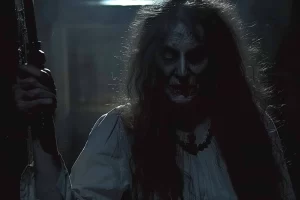The Witch of Pungo

As far as Witch stories go, none is more popular than The Witch of Pungo, Grace White Sherwood.
Take a step back in time to Colonial Virginia in the early 1700s, when witchcraft was to blame for every unexplainable occurrence. There are 19 accounts of witchcraft charges and trials in Virginia during that time. However, the most prominent one was Grace Sherwood, who became known as The Witch of Pungo.
Lost or destroyed records of Grace Sherwood’s life in general before and after her charges and trials keep us from knowing the whole story or truth. However, there is enough information to put together a surmise to most of the events. The rest is left to our imaginations and passed on more unverifiable folklore than actual historical accounts.
There are no drawings or paintings of what Grace Sherwood looked like. Along the lines, the description of her appearance and features has been found as a pretty woman with long brown hair that wore men’s clothing when she tended to her farm and herb gardens. One alleged description is that she was a “negress” (African American), making the evidence of her charges as religious and racial intolerance in the early South.
Being said to have been pretty and intelligent, and humorous, some speculate these traits are the reason for the rumors of witchcraft that were perhaps spread by jealous wives. It is even suggested that others conjured up these allegations to get her removed off of her land to take it for themselves.
Grace White Sherwood’s Life
Grace White Sherwood was the daughter of John White, a carpenter and farmer of Scottish descent, and his wife Susan White of English descent. It is not known if they were born Americans. Grace was born around 1660, most likely in Pungo, Virginia, where she grew up, lived her life, and died.
In 1680 Grace married James Sherwood in the Lynnhaven Parish Church, and they raised 3 sons John, James, and Richard.
Grace’s father gave James Sherwood 50 acres of his land when the couple married. When her father passed away a year later, he willed the remainder of his 145-acre property to James as well.
Life was challenging as it was in those days. The Sherwoods were poor farmers and lived in an area where folks with very little or no land lived out their days.
Grace was a midwife and grew her own herbs that she used medicinally to heal animals and people.
Reasons that someone was believed to be a witch
In Colonial days, many physical characteristics made someone a witch. Often, moles or birthmarks were explained by others as being “witches teets” where the Devil himself suckled to drink the witch’s blood. Other characteristics were scars, being left-handed, having red hair, calluses, or even rashes.
Widows and widowers, the old, the anti-social, and even the grumpy were often believed to be witches. They were the community’s scapegoats. Someone to blame for any unexplained event from the death of animals, children, failed crops, and even storms that caused damage to the farms.
Witches in Virginia Colonial Days
In Virginia, the courts were in charge of neighborhood disputes taking great concern for accounts of slander, gossip, and adultery to keep the social bonds from breaking down.
Witch trials were long, drawn-out, controversial, and costly. Hearsay and slander were not accepted as evidence. The accuser carried the burden of proof, and evidence obtained by supernatural means was not received. Courts found proof of guilt either by “witches marks” or the practice of ducking.
Grace Sherwood was tried by the grounds of both.
The beginning of The Witch of Pungo
In 1697 the first case that came to court for Grace was by a neighbor Richard Capps. He accused her of casting a spell to cause the death of his bull. However, the court made no decision in the case, and Grace counter sued Capps for defamation. The issue was resolved with a settlement.
Another neighbor John Gisburne accused Grace of bewitching and killing his pigs and cotton crop the following year. Although no record of a court action followed the accusations, Grace again counter-filed a suit for defamation, this time failing for settlement.
Later that same year, Elizabeth Barnes accused Grace of assuming the form of a black cat and entering her home through a cracked door in the middle of the night. Allegedly the cat came donned with a whip and beat her, then left through a keyhole. The case was unresolved, and Grace’s countersuit for defamation failed.
Each countersuit of defamation filed by the Sherwoods cost them the courts fees. It was also a 16-mile journey each way to get to the hearings. A high price to pay to proclaim one’s innocence.
A Physical Attack on Grace Sherwood
By the time these cases came to an end, the Princess Anne County had grown tired of Grace Sherwood as a general nuisance.
In 1705, Sherwood was involved in a physical assault with her neighbor Elizabeth Hill. Sherwood sued Elizabeth and her husband for assault and battery and won a settlement of 20 shillings. About $250 in modern-day money.
The Battle with Elizabeth Hill Continues
The accusations and the war with the Hills did not end there for Grace. In January 1706, Elizabeth Hill accused Grace of witchcraft, alleging that Grace had caused the death of her unborn child. Grace failed to answer the charge in court, and in February, the court ordered her to appear.
The court empaneled two juries, both of which were made up of women. The first jury searched Grace’s home in search of incriminating evidence such as baked figures or waxen that might indicate that she was a witch. The second group of jurors was required to search her physical body for “demon suckling teats.” Both groups refused to carry out the tasks.
In March 1706, a jury of 12 “ancient and knowing women” were appointed to examine Grace Sherwood’s body for markings that could be the brand of the Devil. The jury’s forewoman happened to be Elizabeth Barnes, who accused Sherwood previously of witchcraft.
Colonial authorities in Williamsburg and the local court in Princess Anne County were all reluctant to declare Grace a witch. Considering the charge overly vague, Williamsburg instructed the local court to examine the case more thoroughly.
Judge and Jury by Ducking
The county justices noted no particular act of maleficium (any harmful action of witchcraft against people, animals, or property) alleged against Grace. There was still a significant cause of suspicion. In July of 1706, a trial by ducking was ordered, and Sherman gave her consent.
On July 10, 1706, Grace was taken down a dirt road now known as Witchduck Road to a plantation near the Lynnhaven River. News of her ducking spread through the colony like wildfire, and soon more than 60 spectators came to witness the event from the banks of the water. Many yelled out, “Duck the witch!” One can only imagine the fright Grace must have felt amongst her fellow colonists, most of whom she had been around her entire life.
Markings of The Witch of Pungo
Strangely, it was not the intent for Grace Sherwood to die, and authorities took great care of the situation to prevent her from drowning. Five women examined her naked body while on the shoreline to ensure she did not have any devices to free herself.
Her left thumb was bound to her right big toe and her right thumb to her left big toe. Covered with a sack, they put her in a boat and rowed 200 yards out into the river. She was pushed from the ship into the water. Quickly rising to float, the Sheriff tied a 13 lb Bible around her neck. Although this caused her to sink, she managed to free herself and swam to the surface.
Grace was pulled from the water, and several women who had earlier examined her body for markings found additional proof of guilt. Two black marks were believed to be “witches teets.” For this and floating to the surface, she was thrown in jail until further proceedings.
The aftermath of the ducking
There is no record of any further trials for the witchcraft allegations against Grace Sherwood. It is believed that she remained imprisoned for at least 7 years. Once released, records show Grace paid back taxes on her land and returned home to live out her days until 80 years of age.
Was Grace Sherwood indeed the witch of Pungo? Or was she innocent as she proclaimed the entire time and to the time of her death? She had petitioned the courts to clear her name for 20 years. It wasn’t until 2006, some 300 years after the ducking incident, Grace was pardoned by Governor Timothy M. Kaine. A statue and a memorial headstone were put in honor of Grace Sherwood, The Witch of Pungo.
Every July, a strange light hovers over the Witchduck Pond where the ducking took place. Her ghost is said to roam the Ferry Plantation where her trials took place. It is also noted, although not confirmed, that she is buried under a tree on the property.
Read more about the 10 top haunted places in Virginia Beach and decide for yourself what you believe to be truth or folklore. Virginia is said to be one of the most haunted states in the country. If you are ever in the area, be sure to visit one of the many haunted sites, and maybe you will meet up with some of Virginia’s ghosts of the dearly departed.
Sources:
https://en.wikipedia.org/wiki/Grace_Sherwood
Sherwood, Grace (ca. 1660–1740) – Encyclopedia Virginia
Colonial Ghosts – Witch of Pungo, Grace Sherwood
Grace Sherwood, The Witch of Pungo- Truth and Fiction – History Arch
Witchduck Road and Grace Sherwood – Virginia Beach Neighborhood History
